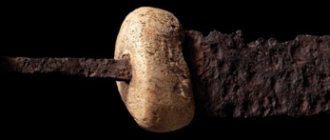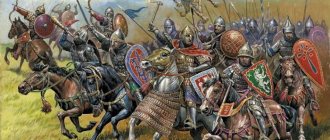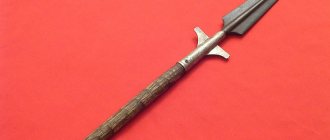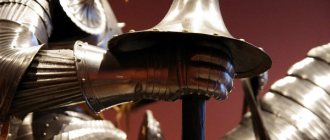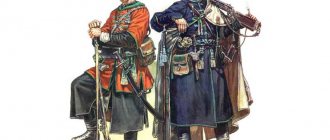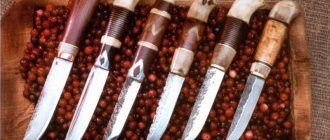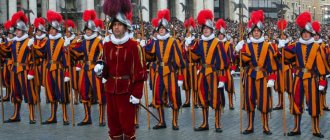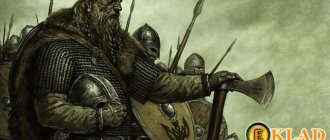The image of a warrior in works of art dedicated to antiquity or the Middle Ages is canonical and easily recognizable. He holds a sword or battle ax in his hands, the more impressive the better. Meanwhile, the real “workhorse of war”, which has gone through fire and water, remains in the shadows. A combat spear, the main weapon from the Stone Age, which did not lose its relevance until the twentieth century.
The heroes, equipped to the latest standards, could still do almost nothing with a group of spearmen in battle formation. At almost all times, even with the spread of firearms, the spear was the main weapon of both infantry and cavalry. This weapon has not undergone fundamental changes over its long history, unlike the same firearms. The short spears of ancient Egyptian warriors, in principle, are not much different from the weapons of a medieval spearman or pikeman of the New Age.
The emergence of copies
The first spears appeared in the early Stone Age. As soon as a person learned to make a chisel with which it was possible to sharpen a wooden stick, the weapons of primitiveness change. The spear, or rather the fort, became the main companion of the people of that era.
Essentially it is a straight stick, sharpened at one edge and with a burnt end. But it is more convenient than a club in many respects. Later they begin to make stone tips on these sticks.
The fastening could be of two types. Either the tip was tied to a stick using ropes or sinews, or the tree was split, and the tip was inserted into the resulting split, also tied with tendons or rope to be sure.
The spear was a universal weapon.
For hunting or military clashes that were already taking place then, it was used both as a melee weapon and as a throwing weapon. To increase range, a spear thrower was invented. It was a long stick with a branch at the end.
The spear was inserted into this stick, the end was on the branch, after which the hunter sharply threw the spear thrower forward. Thus, the leverage increased, and the spear could fly a distance many times greater than from a hand throw.
The spear for hunting gradually became a separate branch; the differences with military weapons were more than significant. The combat spear, in turn, also changed, and new varieties of it appeared.
With the advent of metalworking, spears received a new lease of life. Metal tips, more advanced, made spearmen more effective in the ranks. It becomes possible to make wide blades at the tips to inflict terrible wounds, or, conversely, narrow ones, but with greater penetrating ability.
The main combat unit becomes a group of warriors bristling with spears.
This formation, known as the phalanx, lasted for thousands of years. The infantry, covered with shields and putting out spears along the front, marched towards the enemy.
The blow was strong and irresistible. The cavalry did not even dare to think about attacking the phalanx head-on, since the spears reliably covered the infantrymen. There were also disadvantages to this system.
Only the first two ranks were active, starting from the third rank, the fighters simply did not reach the enemy, entering the battle in the event of the death or injury of the fighters of the first ranks and pressing on them to move forward.
In addition, the use of the phalanx required constant adherence to formation and level terrain. Otherwise, a horseman with a spear or bow could make a hole in the ranks, widening which was a matter of a few minutes.
Over time, the spears transformed, lengthened, and sarissas appeared. This 8-meter type of spear provided even better cover for the warriors and allowed fighters from further ranks to engage in battle. In addition, raised vertically or at an angle, such spears protected the infantry from fire, changing the trajectory of the arrows and knocking them down.
Warriors were trained to use a spear from childhood.
Spartan warriors began to master this art from the age of 7, and nomadic peoples from the age when a boy could hold a weapon in his hands.
In principle, a spear almost always consisted of several parts, namely:
- shaft, or ratovishche, wooden rod;
- cassock or horsetail, on some types of spears, consisting of horsehair to absorb blood;
- a tip, which in turn consists of a feather, a sleeve and, in some types, a neck.
If we consider weapons by time periods, the medieval spear differs significantly in its design and use from the hastat spear of antiquity or the cavalry lance of the 20th century.
The difference is in the material, the method of attaching the tip and, finally, in the shape and size of the spear tip itself.
Build pawns
Why in chess does a pawn (foot warrior) only move forward, but strikes obliquely? Because in a wall-to-wall battle, the warrior moved forward with his shield and hit the gap to the right with his spear that opened between the enemy shields.
However, chess did not reflect another feature of the battle in formation. All pawns on the board are equal. But in battle, the warrior on the far right was always the strongest. After all, since the shield was in the left hand, the warrior needed cover, first of all, on the right side. No one was covering the extreme fighter on the right flank.
Distribution of copies
The type of weapon in question was suitable not only for infantry. From the moment man tamed the horse and created the first prototypes of mounted warriors, we can talk about their arming with spears.
Of course, until the invention of stirrups, it is difficult to talk about the effective widespread use of spears by cavalry. There are exceptions in history.
The Macedonian Geitar, a rider of Alexander the Great's personal guard, was armed with a short spear.
The famous cataphracts, used by the Parthian kingdom and many states of the Caucasus and the Black Sea region, also used spears.
The tactics for using spears to stirrups by cavalry were as follows. The mounted warrior either held a spear under his armpit or tied it to the horse's neck. Using a spear in equestrian combat, especially at high speed, which was the most effective tactic, was dangerous for the rider himself.
The infantry also could not do without spears. The Roman army played an important role in the development of this type of weapon. For the first time, legionnaires receive gladius swords as their main weapons, but they still have spears. They transform into pilums, heavy projectile weapons used before attacking.
The peculiarity of the pilum is that the tip is forged from metal to a great length. Once caught in the enemy's protective equipment, the pilum would get stuck in it and bend, preventing the enemy fighter from fighting at full strength. A legionnaire could step on the shaft and bend the shield to the ground.
Stirrups made a real revolution in military affairs. Heavy cavalry comes to the fore, using spears for the first and often decisive blow.
The infantry, in order to protect themselves from cavalry, adopts pikes, lighter and longer than the spears of the previous time.
The tactics of using them against horsemen is to have the first row rest their pikes on the ground, creating a palisade through which a horse cannot break through; the second and third rows hold the pikes in their hands, almost blindly stabbing both the enemy’s infantry and cavalry.
Spearmen still form the backbone of the world's armies. The throwing spear, called sulitsa in Rus', also remains in service.
Nothing passes without a trace
The phalanx influenced not only the art of war, but also world culture as a whole. Moreover, this influence is still felt. Thus, it was the phalanx that gave rise to drill training. After all, it was only possible to move in tight formation in step. Over time, this became a habit among the military. By the end of the 19th century, this habit seemed to have become harmful, but it was at this time that the Japanese were able to comprehend its hidden meaning. In stepping, a unique method of mental training was recognized, which develops in soldiers the automaticity of following orders and a sense of teamwork.
It is to the phalanx that we owe the emergence of Greco-Roman wrestling. This type of martial art, applicable in a stampede, was once specially developed for phalangists.
Finally, the phalanx introduced a new standard of beauty. Thanks to her, the sign of a real man began to be considered not a thick beard, but a shaved chin. The regulations of ancient armies forbade wearing a beard, since in battle the enemy could grab hold of it. And he - considering how close contact the Falangist came into contact with the enemy - could indeed easily do this. Even the Slavs and Franks shaved in the early Middle Ages, and only later - when the phalanx faded into history - did they stop.
Source
The rise of combat use
Spears and pikes were used almost non-stop at all times, but they showed the greatest effectiveness in antiquity and during the era of the birth of firearms. The firearm solved the main problem of the spear, the low firing range or the inability to reach the enemy at a distance.
From the 16th century, united formations began to form, where warriors armed with arquebuses and muskets were covered by pikemen. The pinnacle of such tactics can be called the tercios, Spanish regiments of combined spear infantry with musketeers and warriors armed with bladed weapons.
Cavalry also actively uses this type of weapon. Light samples and a long knight's spear can be distinguished. The latter were several meters longer than the first and were used to break through enemy infantry formations.
The first, best known as Cossack spears, or otherwise pikes, served not only for thrusting, but also for fencing.
There are many references to how the Cossacks beat enemy horsemen and infantry with pikes.
This also made it possible to use the pike many times, unlike knightly spears, which often broke in the hands. The Cossack spear, unlike the heavy peaks of the regular cavalry, was lighter and shorter.
In total, from the development of the spear and pike the following types of weapons emerged:
- a halberd, a pike with a small hatchet and a hook for pulling the rider off the horse;
- knight's long spear - tournament pike;
- protazan, a spear with a wide blade and a cross to hold the body at the tip;
- a spear, with a shorter tip than the protazan, intended for hunting;
- a trident and a pitchfork, a spear with three or two tips to disarm the enemy.
In addition, there were ersatz spears, such as knives screwed or otherwise attached to a long shaft.
The long spear obtained in this way was often used to arm militia units.
Reconstruction
Almost all nations had spearmen in ancient times. The spear will be an excellent weapon for the Greeks, Romans, Celts, and Germans. In a Roman reconstruction it would be appropriate for use by auxiliaries and hoplomachus.
Spearhead with gold inlay, Germany, 1st century AD.
Spearhead with inlay, reconstruction
Spearhead with inlay, reconstruction
Decline of the era of copies
With the improvement of firearms, pikes and spears are becoming obsolete. The invention of first baguettes, and then bayonets, made it impractical to arm a significant part of the fighters with pikes and spears.
By the beginning of the 19th century, these weapons remained with a few branches of the European armies, the lancers and the Cossacks.
In some places, sergeants and officers continue to have halberds or protazans, universally recognized anachronisms, more decorative details than military weapons.
The peak remained in service for another century. During the First World War and the subsequent Civil War, peaks were already considered an anachronism and were almost never used. They existed in service with the Polish army until 1939. The last combat use of pikes on horseback has been mythologized.
According to sources, Polish cavalry attacked German tanks with pikes at the ready. However, this is not confirmed, with the exception of a couple of cases when cavalrymen thrust spears into the viewing slots of Wehrmacht tanks rushing towards Warsaw. After this, these weapons can be seen in the hands of reenactors and people from the film industry.
Spear in history and culture
The use of the sample for such a long time could not but leave a mark on the culture. The most famous and valuable spear in Europe is considered to be the spear of Longinus, a Roman legionnaire who, according to legend, mortally wounded Jesus Christ.
Modern historical films increasingly pay tribute to the importance of this type of weapon.
Many films are written on the basis of historical and artistic literature, describing both tactics and features of the use of spears and peak battles. Stories related to the Spartans and Macedonians, Spanish Tercios and Cossack units reveal the importance of these weapons, their role on the battlefields of past centuries.
